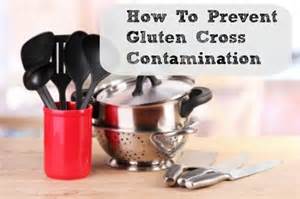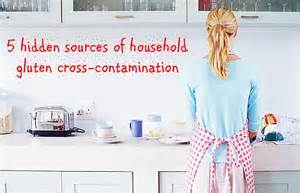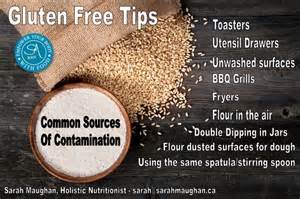Cross Contamination Is A Never Ending Battle
Do you know how gluten cross contamination can occur in or outside of the home? It seems that there are more and more families that have someone who has been diagnosed with celiac disease or has gluten sensitivity. One of the biggest areas of concern is how to avoid gluten cross contamination. This article provides information to aid you in understanding just how important it is to know about gluten cross contamination in areas where it is most prevalent. If you have anyone in the family who is gluten sensitive or has celiac disease, it’s important to convey to all persons the importance of understanding gluten cross contamination and the sources of hidden gluten.
Gluten cross contamination occurs…
- In the kitchen
- In restaurants
- In Supermarkets
- Using the same towel to wipe hands
If you are interested, read on.
Here is a great definition of gluten cross contamination by Dr. Peter Osborne of Gluten Technology: “Cross contamination is when gluten comes in contact with gluten free foods thus contaminating it.” This is a very simple and easy to understand definition. As the meal planner in the home and others living with you, you need to communicate to everyone that cross contamination does not occur and how it can be avoided. You need to get everyone in the family all on the same page in preventing cross contamination.
Below is an excellent video on the effects of gluten cross contamination. Take a look!
Excellent Video On Hidden Gluten & Cross Contamination
Areas Where Gluten Cross Contamination Can Occur
No area is totally safe from contamination unless everyone knows just how contamination is caused. The biggest area of cross contamination usually occurs in the kitchen. The reason for this is it’s the room where the meals are being prepared for both the gluten and gluten free persons in the home and is the most likely place where cross contamination will be found. We are going to address the following areas where contamination is the most prevalent and take some corrective action: kitchen, utensils, cookware, restaurants, baked goods from friends, and supermarkets.
Kitchen
This is the main area where most of the contamination can happen. Why? Because it’s the room where the meal planner prepares both the gluten and gluten free meals in.
- The counter top is a major source of contamination and must be washed thoroughly before placing gluten free foods on it.
- The same is true of the breadboard. You may consider having separate breadboards one for each food group.
- After preparing foods with gluten in them and before handling the gluten free foods it’s important to wash your hands thoroughly and dry them in a separate towel. Do not use the same towel where other family members that ate gluten dried their hands on because it will be contaminated with gluten.
- The same holds true for other family members. After they have eaten or touched foods with gluten, they should wash their hands before handling the silverware when setting the table. Be sure they dry their hands on a separate towel.
- Cooking foods in the same oil as gluten foods like breaded chicken nuggets or anything breaded. Be sure to change the oil or have separate fryers.
As you can see, the kitchen is the hardest and the most difficult area to keep from being contaminated with gluten.
Utensils
The next area of concern is the utensils the whole family uses to eat from. You may need to have separate utensils from the gluten ones being used by other family members. It’s important that you convey to the other members of the family about cross contamination and its effect on gluten free individuals. Don’t forget the utensils you also use to cook with they should be separate as well. Or, be sure to wash them thoroughly with soap and water before using them when preparing gluten free meals.
Consider the silverware tray as it may have some hidden sources of gluten. You may consider storing the gluten free silverware in a separate tray and storing them away from the gluten ones. Here are some other items that may cause contamination that you should consider: the can opener, bread board, wooden utensils, toaster and toaster oven. Be sure to have separate ones of these kitchen aids for gluten and gluten free food preparation. Or, be sure to thoroughly wash them with soap and water before using them with gluten free foods.
Cookware
The next area is the actual cookware being used to cook all the meals in. It may be in your best interest to have separate pots and pans for both gluten and gluten free food groups in the home. This is so you don’t get mixed up on which ones had gluten in them with those that did not. By having separate pots and pans will make it easier for the preparing of all the meals for both groups and help prevent cross contamination.
Restaurants
Many restaurants now offer a gluten free menu items for their customers. Just because they offer gluten free entrees it does not necessary mean that the meal being served to the one with celiac disease or gluten sensitivity can eat the meal safely. It’s quite possible that it may be contaminated with gluten.
How is that, you ask? The chef may not have washed his hands after preparing a gluten meal, forgot to wash any of the pots, pans or utensils before preparing the gluten free meal. The server who brings the food to the table may have touched something with gluten in it and then proceeds to touch the plate and takes the plate of food to the gluten sensitive person.
There is no harm in asking the waitress if she and the chef washed their hands before preparing and the serving of the food to ensure no contamination has taken place.
Baked Goods from Friends
Another area of concern which may be more difficult for the younger children in the family with celiac disease or gluten sensitivity is foods being eaten or exchanged from friends. Tell them not to accept any food that is offered to them or exchanges from their friends. The reason is they do not know how the food was prepared or where it was sitting and it’s possible it may be contaminated. To play it safe, just tell your child not to accept any food from friends at school or friends in the neighborhood.
Supermarkets
Another area of high contamination concern is supermarkets. You would think that the grocery stores would take extra care where the gluten free items are displayed. Not so. As you know, all fresh fruits and vegetables are gluten free and safe to consume. However, these foods can get easily contaminated if they are on a display next to a gluten bin. This happens when a gluten item just happens to fall on the gluten free fruits and vegetables. When this happens, this causes contamination.
Another way for contamination to occur at the grocery store is when a customer that touched any gluten item and then proceeds to touch multiple gluten free items as they look through the gluten free fruit and vegetable bins. All items touched and those items that touched any of the gluten free ones are now contaminated. You may want to make a suggestion to the store manager to separate these bins from the gluten ones so cross contamination will be kept at a minimum.
Can I Prevent Cross Contamination?
It is probably almost impossible to prevent cross contamination at all times. However, with careful planning of the meals and explaining to other family members what causes cross contamination, you should see an increase in family members being active participants and assisting in reducing its effects. Cross contamination is the number one concern for those who have celiac disease and have gluten sensitivity. This issue will be with them throughout their entire lifetime. Another issue is staying on the gluten free diet, since many of the foods they liked before they started the gluten free diet they can now no longer eat anymore.
Hidden Gluten Sources and Products
There are some foods that contain some hidden sources of gluten and you need to be aware of them. Below is a list of hidden gluten foods:
- Bouillon Cubes – May contain GMO’s and other hidden sources of gluten
- Candy – May be dusted with wheat flour to prevent the candy from sticking in the wrapper
- Cheese spreads
- Canned Soups
- Chocolate – May contain malt flavoring
- Cold cuts, wieners, and sausages – May contain some gluten cereal fillers
- Detergents
- Dry sauce mixes
- Face Powder
- Glue on Envelopes
- Glue on Stamps
- Hairspray
- Lipstick
- Lotions
- Makeup
- Maltodextrin
- Medications & Vitamins
- Modified Food Starch
- MSG’s
- Packaged Foods (Be sure to read the label carefully for hidden gluten ingredients)
- Pet Food
- Playdough
- Salad Dressings
- Shampoo
- Toothpaste
Note: Always check with the manufacture to be sure the product is gluten free before buying or consuming.
Conclusion
We know now, that eating contaminated gluten free foods will act as though you have eaten gluten if you have celiac disease or are gluten sensitive. It’s very important to prevent cross contamination. With the information presented here you should be able to succeed with the other family members to help prevent some of the cross contamination of gluten free foods going forward.
Resources To Help You
Below are some resources to help you with a gluten free diet and celiac disease. Just click on any image to purchase the Kindle edition. These books are also available in paperback. You have the option on selecting which type to purchase.
 Celiac Disease Kindle Edition
|
 Jennifers Way: My Journey with Celiac Disease Kindle Edition
|
 First Year Gluten Free Essential Kindle Edition
|
 Celiac Disease Unsafe Essential Information Kindle Edition
|
Did not find what you were looking for? Enter a search term in the Amazon Box below to search on Amazon for other gluten free products.
Go back to gluten free diet with nutrition home page.



